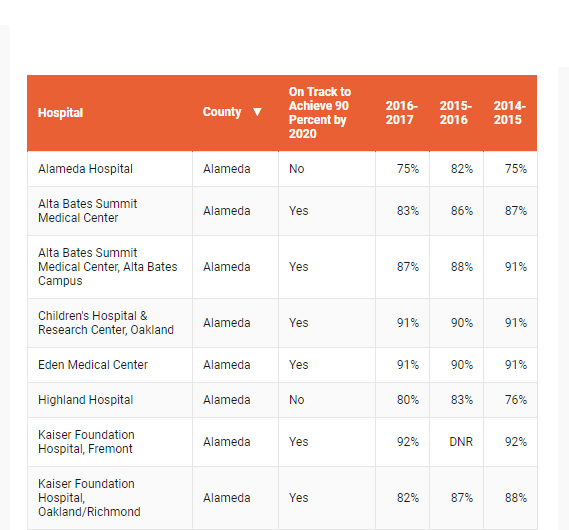How well are doctors, nurses and other workers at your local hospital vaccinated against the flu?
That depends on the hospital.
According to data from the California Department of Public Health, flu vaccination rates among health care staffers at the state’s acute care hospitals range from a low of 37 percent to 100 percent.
Overall, flu vaccination rates among hospital workers climbed significantly in the past several years — from an average of 63 percent during the 2010-11 influenza season to 83 percent during the 2016-17 season, according to the California Department of Public Health. Vaccination rates for the current season won’t be determined until later this year.
But that general increase masks some big variations. Monrovia Memorial Hospital in Los Angeles, Los Robles Hospital and Medical Center, East Campus and Thousand Oaks Surgical Center in Ventura each reported that fewer than 40 percent of their health care workers received the flu vaccine last year. Representatives from those hospitals did not return repeated calls for comment.
On the other end of the spectrum, Rady Children’s Hospital in San Diego reported that every single person working there got the vaccine.
California’s flu vaccination policies for hospital workers, and those of many other states, are far from uniform or ironclad. In various states, health care workers have legally challenged hospital requirements for vaccination on religious and secular grounds. And some unions in California and elsewhere oppose a legal mandate, partly for civil rights reasons.
Public health officials themselves have different takes on the legal requirements for hospital workers. The Centers for Disease Control and Prevention lists California and Massachusetts among the handful of states where the flu vaccination is mandated for health care workers. But the states’ laws allow health care workers to opt out by signing a form declining the vaccine. For that reason, officials from those two states said they do not actually consider the vaccine mandatory.
Colorado law requires hospital health care workers to provide proof of immunization or a doctor’s note providing for a medical exemption, and requires that non-immunized workers wear masks. Hospitals that achieve a 90 percent or higher flu vaccination rate are exempt from these rules, however.
In California, state law requires that hospitals offer the vaccine free of charge. Many hospitals offer vaccines to personnel in the cafeteria, and during day and night shifts. “The key to getting more people vaccinated is to make it more easily accessible for people,” said Lynn Janssen, chief of the California Department of Public Health’s associated infections branch.
She also said many California counties and hospitals have required health care workers to either get the flu vaccine or wear a mask, which can help prevent spreading illness to others.
Partly as a result, nearly a third of the state’s hospitals now have flu vaccination rates above 90 percent.
Vaccination rates vary significantly among different categories of hospital workers, however. Hospital employees had an average vaccination rate of 87 percent statewide in 2016-17, while licensed independent practitioners — including some physicians, advance practice nurses and physician assistants who do not receive paychecks from the hospital — had a rate of just 67 percent.
The CDC recommends that health workers get one dose of influenza vaccine annually, and cites data showing the vaccine in recent years has been to up 60 percent effective — though it was far less so this year. Dr. Bill Schaffner, an infectious diseases professor at Vanderbilt University School of Medicine in Nashville, Tenn., says there are three principal reasons to get vaccinated: to prevent workers from infecting patients, to keep them healthy in order to care for patients and to spare them a bout with the flu.
A 2017 Canadian study, however, suggests that the benefits of health care worker vaccinations have been overstated.
In any case, just because experts say health care personnel should get the vaccine doesn’t mean they will choose to do so.
“In the studies, and also in our experience, it turns out — to everyone’s great surprise — that health care workers are human beings,” Schaffner said. “Some are too busy, some don’t think the flu vaccine is worth it, some don’t like shots. Some are not convinced they can’t get flu from the flu vaccine.” (Experts say they can’t.)
Because of this, Schaffner said, it’s up to hospital leadership to push staffers to get vaccinated. At Vanderbilt University Medical Center, vaccination rates increased from 70 percent to 90 percent once leaders there effectively made the flu vaccine “mandatory,” he said, requiring noncompliant hospital personnel to present vaccine exemption requests to a hospital committee.
Health officials also encourage patients to ask whether their caregivers are vaccinated.
Jan Emerson-Shea, spokeswoman for the California Hospital Association, said her organization would like the flu vaccine to be mandatory for all health care personnel. Independent physicians have proven an especially challenging group to motivate, she said, since hospitals hold little sway over them.
“I, for the life of me, can’t imagine why a physician wouldn’t want to be vaccinated,” she said. “But they make that choice.”
Yet the California Nurses Association strongly opposes making flu vaccines mandatory, said Gerard Brogan, a registered nurse and spokesman for the union.
He said the union does recommend that providers get the vaccine, but it objects to making vaccination a condition of employment. He said some employees have religious issues or safety concerns about the vaccines and “we think that should be respected as a civil rights issue,” he said.
He also called rules requiring unvaccinated providers to wear a face mask “punitive.”
“It’s almost like the scarlet letter to shame you,” he said.
He said the masks can frighten patients — a contention made by a New York union as well. In any case, he said, wearing the masks is not especially effective in stopping the spread of flu (although some researchers say otherwise). Instead, he said, employees should be encouraged to wash hands and to stay home when they are sick.
Too often, he said, nurses are asked to come in to work when they are ill. He said he was not able to find any nurses willing to discuss their decision not to get the flu shot.



